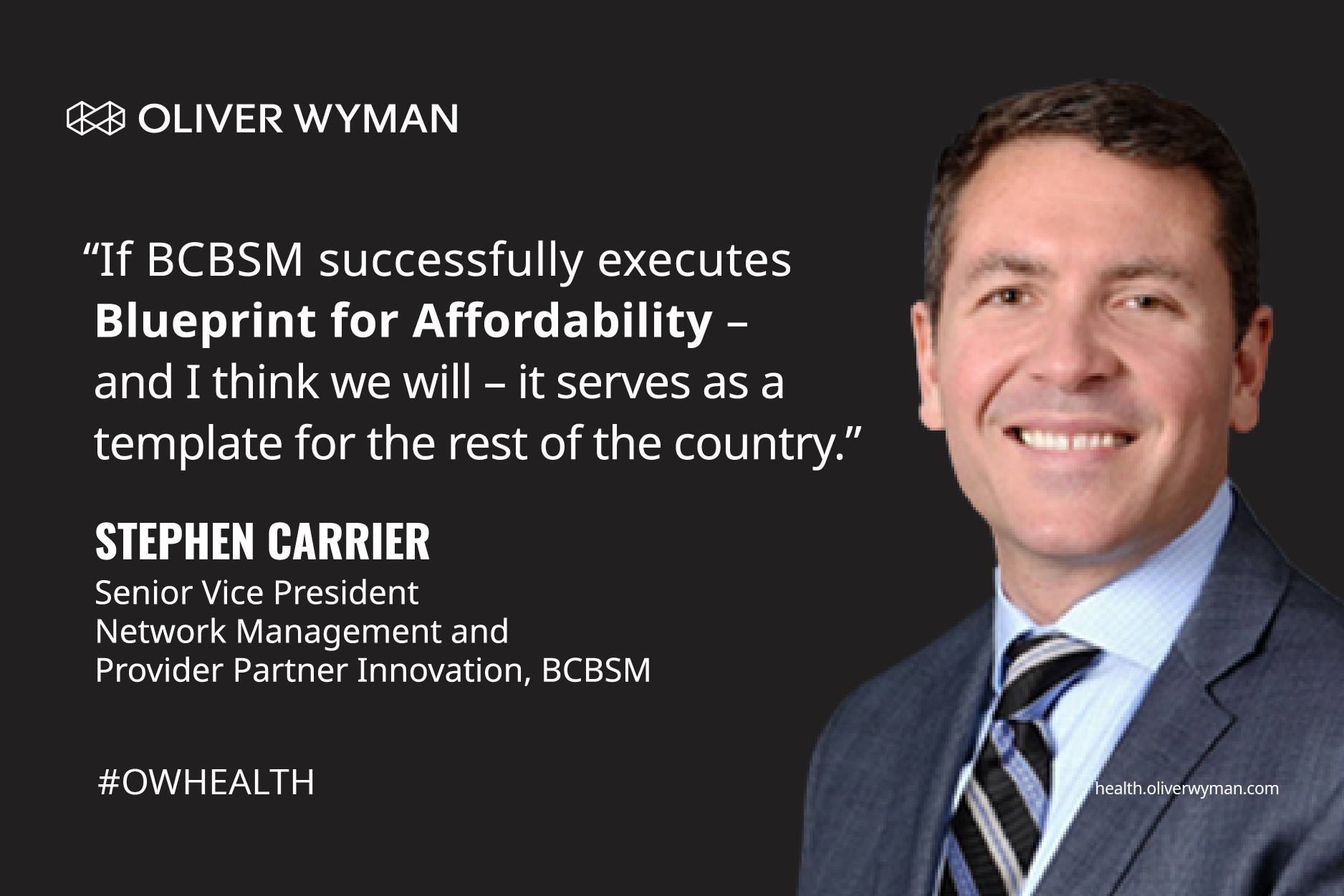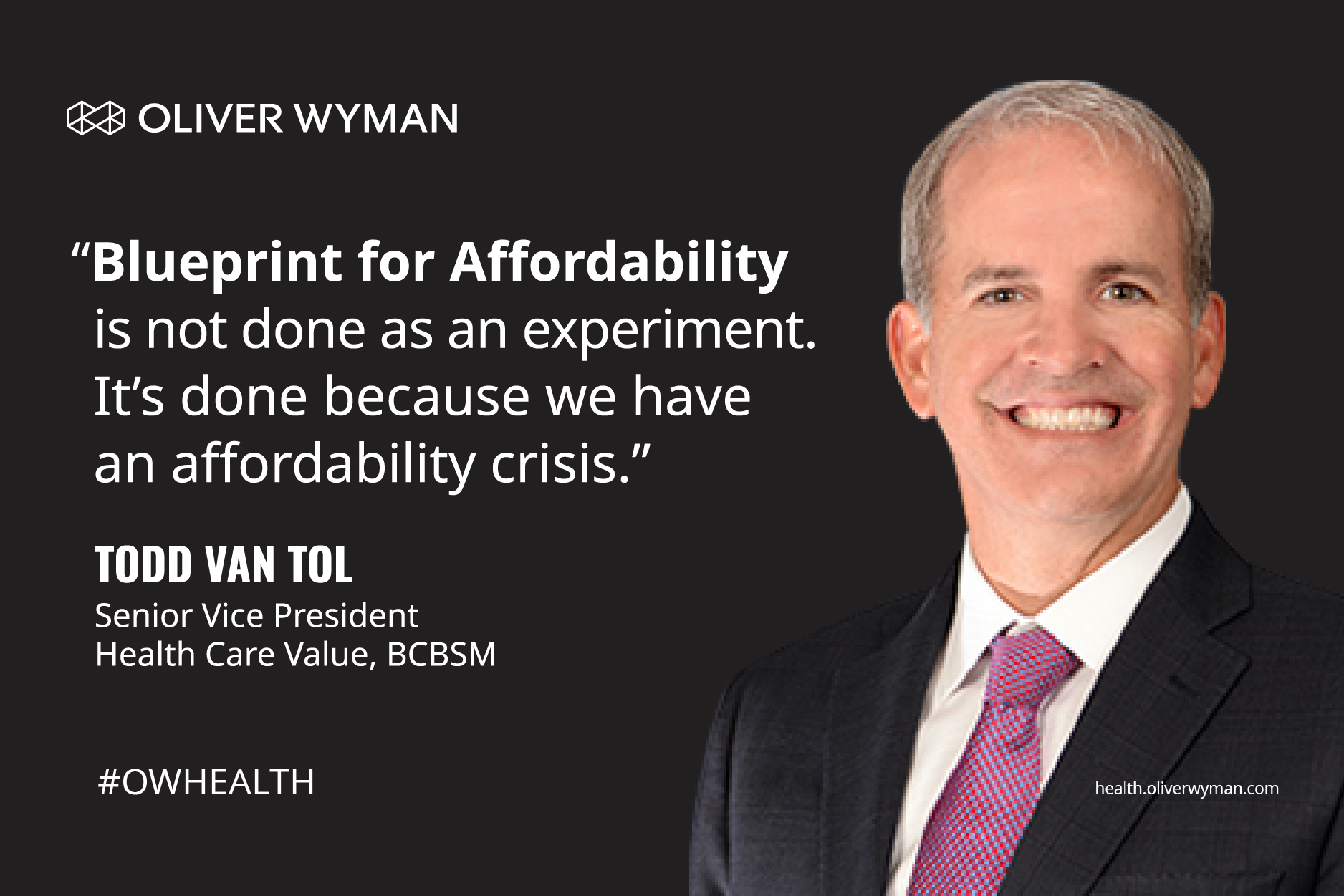Editor's Note: The following is a summary of a December 2019 media call for reporters where BCBSM explained its new affordability initiative.
Healthcare providers in Michigan are putting their money – not just their reputations – on the line to transform away from sick care, thanks to Blue Cross Blue Shield of Michigan’s (BCBSM) new financial risk contract initiative. Called “Blueprint for Affordability,” this next step in the evolution of BCBSM’s provider relationships involves a new contracting and partnership model that rewards physicians based on the value, not the volume, of their care delivery. Here, providers may actually write checks back to the payer and their customers to cover spending overages for their population.
Joining BCBSM to help transform how care is managed and paid for in Michigan are seven health systems and physician organizations in the Southeast region of the state – Ascension Michigan, Henry Ford Health System, Michigan Medicine, Oakland Southfield Physicians, The Physician Alliance, Trinity Health – Michigan, and United Physicians. All have signed risk-sharing agreements to help make healthcare lower-cost and higher-quality in the region with BCBSM working to expand the model across the rest of the state in future waves.
Making Value an Imperative
“What makes Blueprint different? It’s not just an upside payment for doing something extra. From a cost standpoint, we’re putting the provider in the same boat as the insurance company and our customers. There’s a set amount of dollars we have to work with, because we can’t just keep running up healthcare costs,” Stephen Carrier, BCBSM’s Senior Vice President of Network Management and Provider and Partner Innovation, told Oliver Wyman.
“We’re telling providers we have a cost target. If you stay within that target – at or under – we’ll pay you something extra. But if you come in above that amount, the provider has to take some financial accountability for the higher cost of serving that population in a high quality manner.”
Although this idea, he said, isn’t new, execution of this idea is new.
“Those managing risk-based payments in today’s market typically select a product or try it on a subset of their population. But it’s more of a ‘toe in the water’ effort. Conversely, with Blue Cross Blue Shield of Michigan, we’ve committed to engage our entire preferred provider organization (PPO) network– both Medicare Advantage and Commercial – in ‘Blueprint’. … We also see this as more than a contract. That part is just the beginning. We need to collaborate more closely and share better data and insights to empower our providers to actually transform care. Signing the contract is the easy part.”
“Regarding the greater implications of the announcement, as a nonprofit mutual company and a healthcare leader within Michigan, it shows we have heard our customers. We know we need to make some changes to tackle the larger affordability issue,” he explained. “We have enough market share to drive this, and we can make a change in Michigan. The broader impact is that if BCBSM successfully executes this – and I think we will – Blueprint serves as a template for the rest of the country as payers and providers work toward jumping into the same boat from a budget and cost perspective.”
“Blueprint for Affordability is not done as an experiment. This is done because we have an affordability crisis. This is done because we have plan sponsors and individual members who are struggling and frustrated by the growing cost of healthcare. This starts from a real burning platform – we need more value in healthcare and we must find ways to have it hit our customers’ P&Ls and our members’ budgets less than it does now. It’s an imperative,” Todd Van Tol, Senior Vice President of Health Care Value at BCBSM, and a former Oliver Wyman Health & Life Sciences partner, told Oliver Wyman.
“Because of our plans’ strength and history of leading, innovating, and working closely with providers on care delivery and payment innovation efforts over the past 15 years, Michigan has stronger systems of care across the state with a focus on quality and value. We have a strong foundation of provider partnership to build from,” said Todd. “We have several leading, committed provider partners willing to take this on with us because of an intense need for more affordability in healthcare. We are capitalizing on Michigan being uniquely situated to lead; our deep healthcare institution relationships and history as a leader in the state is not in place in every market, and largely drives why we have the opportunity to play more ambitiously in terms of the scope and impact of our offerings.”
More from Those Who’ve Already Signed on About How “Blueprint for Affordability” May Impact the Greater Industry
Both Stephen and Todd joined the seven aforementioned organizations to explain for reporters on a December 11, 2019 media call how they’re planning to transform how healthcare is delivered, managed, and paid for across Michigan. To help our readers better understand this initiative in more detail, here are four key takeaways from this conversation:
1. Risk-based contracting isn’t unique to BCBS (but it is unique to Michigan).
Said Todd, “Blueprint for Affordability” will initially kick off in Southeast Michigan. The providers who have signed a Blueprint contract represent about 30 percent of Blue Cross members in their commercial PPO and Medicare Advantage PPO lines of business. The total healthcare spend across these lives is $4 billion.
This program operates at a population level, he emphasized. Participating organizations already have BCBS members assigned or attributed to their system of care. It’s these members for which they are measured and held accountable. Risk-based contracting, something the Centers for Medicare and Medicaid Services (CMS) endorses, is already happening across other Blue Cross markets in states like Massachusetts, New Jersey, and North Carolina, Todd explained.
“Taking the shared-risk concept to the Commercial PPO and Medicare Advantage PPO markets is a first for Michigan,” Todd emphasized. “We will have these two-sided risk arrangements where, based on performance on cost targets and meeting quality thresholds, the organizations participating in this will share in strong performance where we beat cost trend targets and budgets. And we’ll share back with providers who successfully achieve those goals. But then we’ll also hold accountable those that don’t perform and ask them to help cover some of that in the downside risk model.”
Added Stephen, the seven organizations’ risk-sharing contracts are effective on January 1, 2020 and cover Blue Cross Commercial PPO and Medicare Advantage PPO plans in Michigan.
2. What makes this initiative different? Downside risk.
Compared to existing value contracts with potential for upside gain, Stephen said what makes these risk-sharing contracts unique is their downside risk component. (An example of this downside risk is when a population that’s not well managed results in more and more above-budget services being needed. When downside risk is in play, as opposed to the plan paying for those additional services, payments above the budget are borne by the provider and effectively aren’t reimbursed by the payer.)
“Now in these ‘Blueprint’ contracts, providers are putting a portion of their payments at risk by sharing financial accountability for patient care and outcomes. Each physician organization and health system has agreed to annual targets for the total cost of providing care to Blue Cross members. These targets are identified using each entity’s prior year of total cost of care data and a state-wide total cost of care average.”
“[This model] rewards doctors for the total cost of care for a patient,” said Dr. Mike Williams, Chief Executive Officer of United Physicians. “Under the old model, the patient gets sick, they go to the doctor, and the doctor would treat them. In this model, the doctor is looking and saying, ‘Who do I think might get sick? Is it flu season? Did this person get the flu last year? Maybe they were admitted to the hospital because they had the flu. I’m going to give them a call and get them in. I haven’t seen them in more than six months.’”
“What we’re trying to do is put the customer and the provider and the payer all in the same boat to say, ‘Here’s the actual target for cost for this year’. And if the doctor comes in below those costs, then we would pay them a bonus. If they come in over those costs, then they would pay something back.”
Added Mike, “Partnering together to address the cost conundrum is the only approach that will make healthcare more affordable for residents of Michigan.”
“In this model, the doctor is looking and saying, ‘Who do I think might get sick? Is it flu season? Did this person get the flu last year? Maybe they were admitted to the hospital because they had the flu. I’m going to give them a call and get them in. I haven’t seen them in more than six months.’”
3. This initiative hits the industry at a time when affordability is huge focus for US employers.
Indeed, affordability is the current chief focus for US employers, added Robin Damschroder, Executive Vice President and Chief Financial Officer at Henry Ford Health System. She specifically cited Mercer’s 2019 National Survey of Employer-Sponsored Health Plans. According to this survey, cost growth remained moderate in 2019, with another year of single digit cost growth – but the growth in total health benefit cost per employee has consistently outpaced the rise in inflation and in workers’ earnings for the last 15+ years. The result is the affordability issue Todd and Stephen referenced. In the past, employers have shifted costs to employees through higher-deductible plan options, but in recent years, both large and mid-size employers are hitting the pause button on cost-shifting to employees. The average individual deductible in the US is nearly $1,600, which means some consumers must decide whether to pay their deductible or their rent. With employers feeling the heat to manage costs rather than increasing deductibles further, they’re demanding their health plan partner do more to manage total healthcare spending and reduce overall administrative costs.
“We know that a truly holistic approach to health and wellness includes addressing other challenges our patients and members face. And that’s why we’ve made significant investments in addressing social determinants of health, including partnerships that provide access to healthy food, apprenticeship programs to remove underemployment barriers, development projects to create thriving neighborhoods, and advocacy efforts to advance transportation access. Today we are proud to take this next step with our partners,” said Robin.
“Our doctors understand that partnering with their patients to manage cost is a critical component of compassionate and personalized care. Our physicians are continually focused on creating innovative alternatives that result in the highest quality of care at the lowest cost,” she added.
4. This isn’t just a contract. It’s a step change in the future of care delivery.
Added Jerome Frankel, DO, Medical Director at Oakland Southfield Physicians, physicians for the longest time were paid for patients coming into their offices and charging an office visit and any other services that were rendered within that visit. “This is a radically new change,” he said. “No matter what their age is, no matter what other services are rendered, it depends on how well that patient is doing after they leave the office. It is totally based on their result from their visit, and this is the real game-changer, because as the patients are treated better, number one, costs are controlled.”
“If [patients] are not taken care of in a decent and well-meaning fashion, the doctors are not going to be reimbursed in a very significant amount. And it will force all of us in the community to provide the care they need to prevent illnesses and hospitalizations.”
Did you know? One in three Americans is a BCBS member.
Closing Thoughts
According to Oliver Wyman analysis, value-based care’s evolution will continue to be a focus for BCBS plans, if only simply because of the organization’s massive size – BCBS has over 106 million members nationwide. One in three Americans holds a Blue Cross insurance card.
While the transition from volume to value hasn’t happened overnight, not long ago (in 2012) only three percent of primary care doctor payments came from value-based contracts. In contrast, Blueprint makes providers responsible for 100 percent of their attributed membership’s cost of care. Programs like ‘Blueprint for Affordability’ are one important step the Blues are taking to make healthcare more affordable for all and empower and equip providers to transform how they deliver care.



